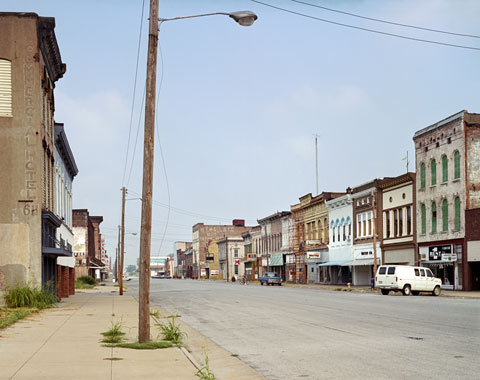
Commercial Street, Cairo, Illinois, 1989 (4×5 film) — © Brian Rose
With all the news about Osama bin Laden, less attention is being paid to an ongoing drama in the heartland of the U.S. The Mississippi and Ohio Rivers are running extremely high, threatening multiple locations, but especially the historic town of Cairo, Illinois. Cairo was once a bustling trading center at the confluence of the two rivers with its own custom house and 15,000 people. There were hotels, theaters, and fine mansions. As river transportation fell off, Cairo slipped into decline, which was exacerbated by racial segregation leading to riots in the ’60s, and wholesale white flight. Today, much of Cairo is a ghost town, its main street a ragged line of crumbling buildings interspersed with rubble strewn lots.
In 1989 I traveled with my view camera along the Ohio River from Pittsburgh to Cairo–another of my unfinished projects–due to lack of money. After two or three weeks of shooting, driving southwest along the river, I finally made it to Cairo having no idea what to expect. It was then, as now, a shocking tableau of abandonment.
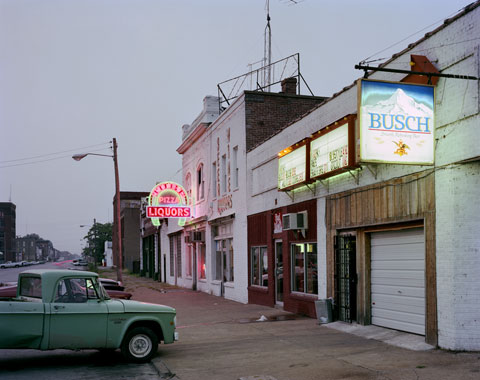
Commercial Street in 1989, Cairo, Illinois (4×5 film) — © Brian Rose
Along with the abandonment there was a palpable whiff of danger in the air, a few pick-up trucks pulled up at bars, solitary individuals drifting about with no apparent destination. Despite the menacing atmosphere I managed to take a few photographs as the sun went down, and then returned in the morning. Things were much less scary in broad daylight, but equally devoid of activity. As I wandered about with my camera I was approached by a middle aged who turned out to be the head of the chamber of commerce. The fact that an out of town photographer was interested in the place was reason enough for him to invite me to lunch at a nearby diner. He wanted to bring Cairo back–a middle-aged white man in a largely black city–but his blue-suited boosterism, seemed out of time and out of step in this scene of desolation.
That was in 1989–and almost nothing has changed in 22 years except that much of Cairo’s extraordinary architecture has further decayed or has disappeared altogether. In the intervening years some of the historic mansions have been preserved as has the old custom house. But the downtown remains spectral, made all the more so by fancy brick paving stones and retro lampposts on parts of Commercial Street, a superficial attempt at revitalization.
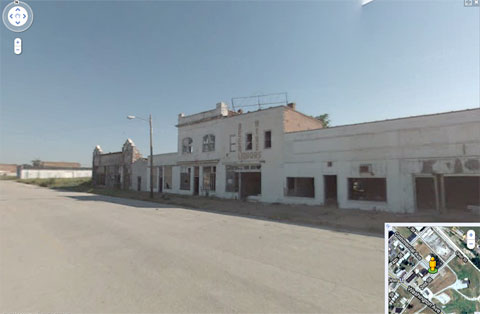
Google Street View of the same stretch of storefronts as above.
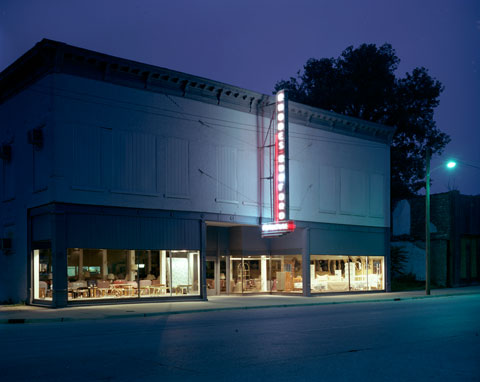
Commercial Street in 1989, Cairo, Illinois (4×5 film) — © Brian Rose
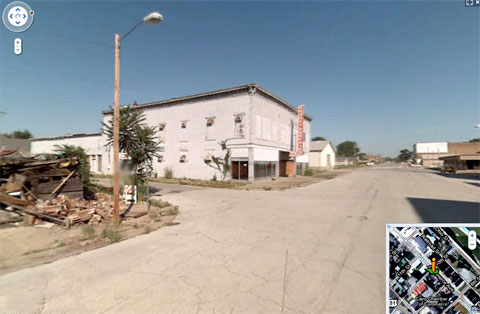
Google Street View of the same building as above.
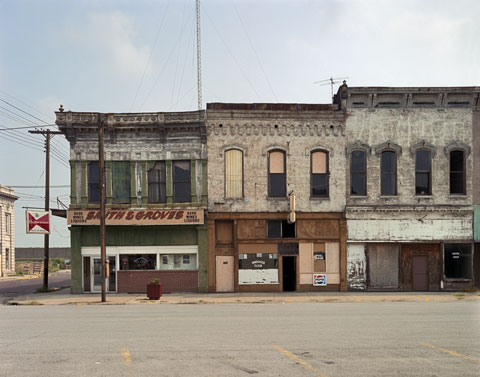
Commercial Street in 1989, Cairo, Illinois (4×5 film) — © Brian Rose
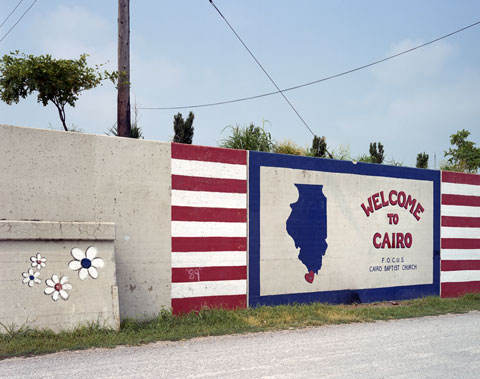
Ohio River levee in 1989, Cairo, Illinois (4×5 film) — © Brian Rose
The reality is that Cairo is a doomed city, a wedge of river sediment between the Ohio and Mississippi walled in by levees. A desperate fight is underway to save the city as the river water threatens to top the flood walls and ground water pressure builds underneath. The city’s 3,000 residents have been evacuated. Yesterday, the Army Corps of Engineers blasted an opening in a levee to the south flooding miles of fertile farmland to relieve the pressure. As of this morning, the levee breech seemed to be working, the water subsiding, but Cairo remains vulnerable. It may survive this season’s flood, but how long can a sandy spit of land withstand the uncontrollable force of two mighty rivers?
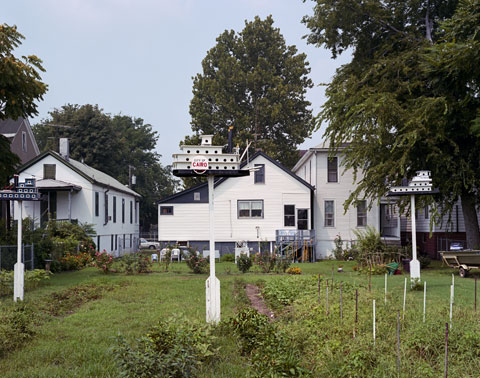
Cairo, Illinois in 1989 (4×5 film) — © Brian Rose
Birdhouses in the form of barge tows, a thematic reminder of why Cairo exists where it is. But the river transit that once made this a thriving small metropolis faded like the car industry faded in Detroit, another symbol of American decline. Or if not decline, then abject neglect, a too easy eagerness to shift attention to the next boom town, to the next swath of exurban frontier. Detroit may yet rise from the ashes, but Cairo sits betwixt and between, imprisoned by its history of racial strife and its impermanent geography.
In Mark Twain’s Adventures of Huckleberry Finn, Huck and the runaway slave Jim float down the big river on the lookout for Cairo, where the clear Ohio water meets the muddy Mississippi. Cairo is Jim’s gateway to the Ohio River and freedom, but they missed their landmark in the fog and drifted on south into slave territory.
There warn’t nothing to do now but to look out sharp for the town, and not pass it without seeing it. He said he’d be mighty sure to see it, because he’d be a free man the minute he seen it, but if he missed it he’d be in a slave country again and no more show for freedom. Every little while he jumps up and says:
“Dah she is?”
But it warn’t. It was Jack-o’-lanterns, or lightning bugs; so he set down again, and went to watching, same as before. Jim said it made him all over trembly and feverish to be so close to freedom.
Fascinating pictures! I hope it survives the flooding.
The whole story of flood control on the Ohio and Mississippi is fascinating. As is well-known in the Netherlands, the channeling of rivers lead to other problems. And a problem solved in one place is often a problem shifted downriver. Cairo has survived this time–and now the flood crest has moved south threatening the Louisiana Delta. Extraordinary efforts are being made–yet again–to save New Orleans. All you have to do is look at a map of the Delta to see how fragile everything is down there. The system seems to be functioning just well enough, shunting the water to other streams in the Delta and flooding sparsely populated farmland. But next time?
Brian – thanks for posting these fascinating images of Cairo back in ’89. We’re making a feature length documentary about Cairo( http://www.betweentworivers.net) and these photographs offer a valuable and moving retrospective of a period in Cairo’s history that is not widely documented visually. There is a book by Ron Powers ‘Far from Home’ (1993 I think), which is well worth a read; it had a very mixed response from the citizens of Cairo and is highly personal/anecdotal but is still an important piece.
Wow, I’m really looking forward to your film. I think there’s an important story to tell concerning Cairo. And I’ll look for the Ron Powers book.
Cairo looks beautiful to me. Hope the real estate developers of Long Island City (or their clones)don’t get hold of it.
Cairo was a major railroad town, years ago and was always busy. I remember being told as a child in the car in the ’60’s & 70’s, before entering East St Louis and Cairo, to ‘lock the doors!’ Love the photos in 1989, I remember the ‘Gem’ as a video store and the furnature store. There were so many beautiful buildings in the 80’s, along main street and all over the place, but no digital cameras and film was at a premium, you had to make every shot count and most of the time you didn’t take photos, due to the expense. I lived 65 minutes south, below Fulton,Ky in 1986-88 and would chase trains all over the place, including Cairo. I remember when Amtrak stopped at North Cairo, and when they stopped serving Cairo in 1987. Some towns you visit you go back in time, when visiting Cairo, you are shocked to see what is left, and glad to leave in one piece. It brings back pleasant memories, and at same time, shocked to see what is left, when reality sets in.
65 minutes south of Cairo, just below Fulton at Martin
Much of what you see in these pictures is no longer there today. I’ve retraced my steps on Google maps, and it’s very sad to see that most of the main street was simply torn down.